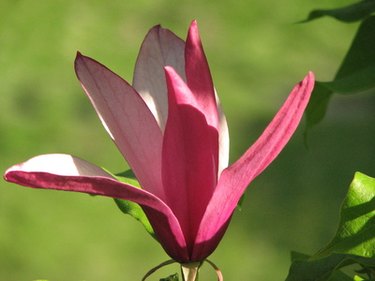
There are many types of magnolia trees, but the southern magnolia (Magnolia grandiflora) is a large, spreading canopy tree with a shallow root system. These magnolia tree roots typically don't damage foundations, but it's best to plant this tree in an area where it has room to spread rather than near a house, patio or sidewalk.
Magnolia Tree Roots
Video of the Day
The southern magnolia grows in U.S. Department of Agriculture hardiness zones 6 to 10, although it is native to the central and southeastern coastal plains from North Carolina to Florida and Texas. This tree grows from 60 to 80 feet tall, and its roots can extend three times the size of its canopy.
Video of the Day
There are many cultivars of magnolias in the Magnoliaceae family, varying considerably in size. So you may find a smaller magnolia cultivar that may be more suitable for your yard or near a patio. While magnolias have shallow roots, their roots are rarely the cause of damage to foundations.
A smaller type of magnolia that may be better suited to backyards is the sweetbay magnolia (Magnolia virginiana), which can reach from 10 to 35 feet high and wide and is hardy in USDA zones 5 to 10. These trees grow well in acidic, medium to wet soils in full sun to part shade. Experts consider these excellent foundation and patio plants.
Roots, Foundations and Pavements
Although tree roots, including magnolia tree roots, are often blamed for causing havoc to house foundations, they rarely are the problem. Roots typically do not cause cracks in the foundations of buildings. Instead, that is usually caused by the settling of soil. If soil should shrink from drought, roots may suck up some of the water in the soil. If the foundation is shallow, this could result in some damage.
If tree roots are too close to pavements or hardscapes, they can eventually cause the hard surface to lift. The way to prevent this is to plant a tree at least 4 feet away from the pavement or choose smaller plants near hard surfaces.
Tree roots have blocked damaged underground pipes, although even this is rare. Pipes are more likely to fail because of age or soil movement, which could allow tree roots to penetrate pipes. Modern materials for pipes and joints, however, are unlikely to suffer damage from soil settling, and therefore unlikely to result in tree roots growing into pipes.
Magnolia Tree Characteristics
Southern Living magazine recommends not planting the traditional southern magnolia in the backyard, because of its extensive root structure, its large size and its tendency to drop leaves year round. Nothing will grow under the tree, so the area beneath it should be mulched to prevent erosion.
Besides sweetbay magnolia, another type of magnolia that is suitable for smaller yards is the star magnolia (Magnolia stellata). This tree, also called the tulip magnolia, is hardy in USDA zones 4 to 9 and grows to a height of 15 to 20 feet with a spread of 10 to 15 feet. This can also be trained to grow as a shrub.
'Bracken's Brown Beauty,' a cultivar of southern magnolia, is a much more compact version of magnolia that is suitable near decks and patios, and along streets. These trees, hardy in USDA zones 5 to 9, grow 20 to 30 feet tall and spread 15 to 25 feet wide.
- Clemson University Extension: Magnolia
- Morton Arboretum: Tree Root Problems
- Missouri Botanical Garden: Magnolia Virginia
- Southern Living: 12 Trees That Will Ruin Your Yard
- North Carolina State University Extension: Magnolia Grandiflora
- Arbor Day: Star Magnolia
- Missouri Botanical Garden: Magnolia Grandiflora 'Bracken's Brown Beauty'